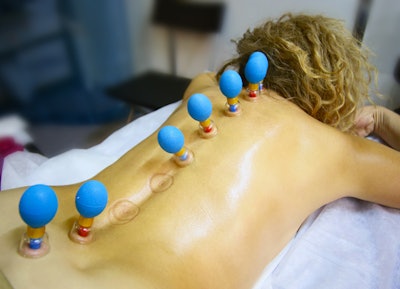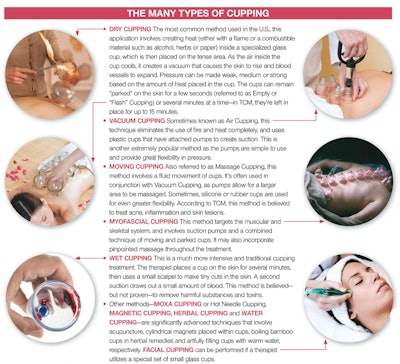 [Images: Getty Images]
[Images: Getty Images]The concept of cupping may be little understood, but it’s actually a simple yet effective alternative health service that’s been used for thousands of years. The treatment has numerous variations and methods, many of which date back to Ancient Egyptian and Middle Eastern times, and some of which are rooted in Traditional Chinese Medicine (TCM). One of the earliest references to cupping can be found in the early medical textbook Ebers Papyrus and describes how the Ancient Egyptians used the therapy in 1550 B.C.
Cupping is beloved for its ability to relieve back and neck pain, increase blood flow and help heal overworked muscles—which is why it’s commonly used by athletes. The technique can be employed to provide clients with everything from deep tissue release to lymphatic drainage; some even believe the therapy lowers cholesterol, alleviates migraines and relieves arthritis pain. Whatever its intended purpose, the process often transports people into a deeply relaxed state.
Is Cupping Right for Your Spa?
It goes without saying that before introducing any new service to a spa environment, it’s important to determine whether your guests would actually be interested in it. If your client base frequently comes to your massage therapists for deep tissue massages to relieve chronic back pain, it may be worth inquiring if they’d be open to alternative therapies such as cupping. It’s often the clients who regularly work out and have pinpointed muscle pain who can most benefit from it.
RELATED: The Benjamin Hotel Launches In-Room, On Demand Meditation
Next, it’s crucial to hire a certified cupping therapist. The practice isn’t well regulated; however, many courses provide certification as a Certified Massage Cupping Practitioner (C.M.C.P.). These include offerings at ACE Massage Cupping & MediCupping, taught at various schools across the country. TJ Mundell, L.M.T., M.T.I., owner of Green Lotus Spa & Wellness in Dallas and Colleyville, Texas, initially experienced cupping from a new therapist at his spa. “I have the worst lower back pain; I went to chiropractors, got massages every day, tried acupuncture… nothing was working,” recalls Mundell. “On this MT’s first shift she performed a cupping treatment on my back. After 20 minutes, my pain was gone. I added cupping to our menu the very next day.” In fact, he was so taken by the therapy that he traveled to Shunkoin-Temple in Kyoto, Japan, the following year to learn more and obtain his certification.

Once Mundell decided to offer the service, the next step involved properly and cautiously marketing it to clients. But his hard work paid off : “In three years, I’ve never had a negative response from any of my clients,” he says, and attributes the success to his diligence in building trust by educating them about the therapy. “I always advise people to avoid Googling ‘cupping’—especially images—it can really scare them,” he laughs.
“I let clients know that they’ll have round marks from the cups for several days because the cups are pulling red blood cells from their interstitial tissues and from old injuries. The pressure is breaking the capillaries as well, allowing the lymphatic system to take away those dead red blood cells and enabling controlled trauma. The process is sending endorphins, white blood cells and fluids to that area,” says Mundell. “Also, I don’t call cupping marks bruises. I call them cup kisses!”
RELATED: Why Rose Is a Skincare All-Star
Hammett reports that his clients appreciate cupping more than a typical deep tissue massage. “For many of the people I treat, the work they need done has previously been performed in a way that they felt ‘beat up,’ or simply sore and exhausted for several days,” he explains. “Cupping lets them get the results they want, which last longer.” Maureen Walker, a massage therapist at The Spa at Four Seasons Hotel Las Vegas, has had similar reactions from her regular clientele. “When used in a series, the results of cupping are certainly cumulative, yet even in a single treatment, long term physical issues may be resolved,” she explains.
For Hammett, cupping is excellent for his clients but it’s beneficial for him too. “It can take some time to get a client comfortable enough to allow for deeper work. The cups cut right to the chase, and seem to have a more lasting effect,” he reports. “They also do a fair amount of the work for me, which allows me a potentially longer career. Who wouldn’t want that?”

–by Rachel Kossman











